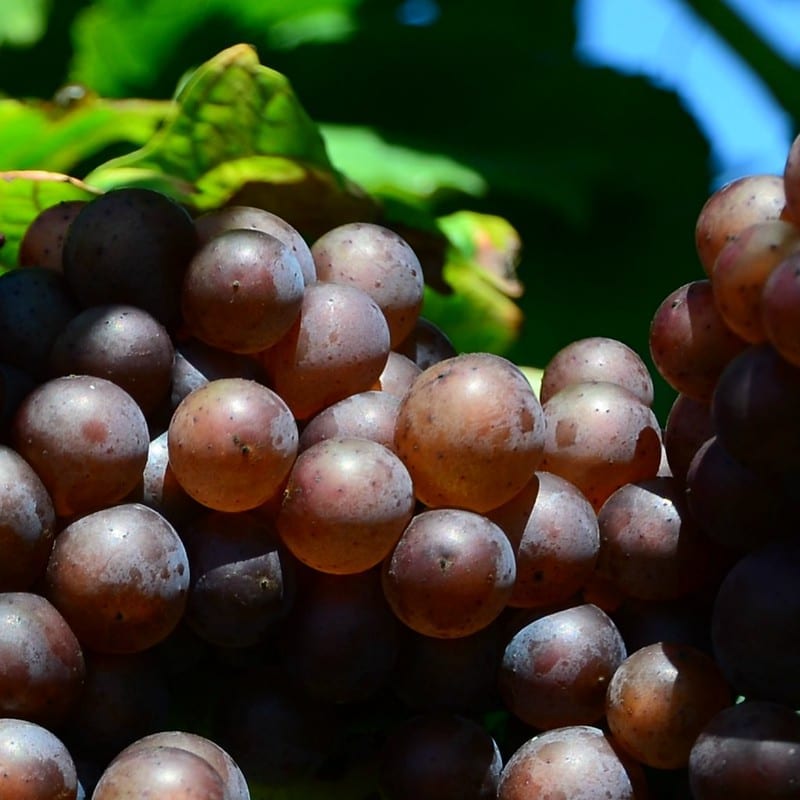There are few grapes that are capable of such an exciting range of expressions as Pinot Gris. Before your eyebrows raise too high in skepticism, know that the challenge is to see beyond the vast volumes of boring, “varietally correct” versions which flood the market. There are bottles and barrels of discovery that await you in a finely tuned Pinot Gris. One of the most expressive and masterful producers comes from Alsace, France: Domaine Zind-Humbrecht.
Pinot Gris, a Versatile Mutation
First, a little bit about Pinot Gris. Pinot Gris is the best-known mutation of Pinot Noir (the other famous mutation being Pinot Blanc). This means that somewhere along the line, Pinot Noir vines underwent a natural mutation that resulted in the Pinot Gris grape. Pinot Gris berries, when ripe, appear anywhere between grayish-blue to brownish-pink to dark violet or almost black.

Pinot Gris generally ripens early, accumulating sugar quickly while simultaneously losing acidity rapidly, making the harvest moment critical to the vigneron’s objectives. Harvest the grapes too late, and the wine lacks the backbone of acidity and will taste “flabby” and one-dimensional. However, if the grape is in the right type of vineyard site – misty mornings and sunny afternoons are perfect – then producers may hold out on harvest so that botrytis (noble rot) can form on the thin skin of Pinot Gris to produce concentrated, sweet wines like Selection de Grains Nobles.
Pinot Gris Pseudonyms around the World
My Zinfandel is your Primitivo, my Tempranillo is your Cencibel, and my Pinot Gris is your…see below. Pinot Gris is known by different grape names around the world:
- Pinot Grigio – Italy, of course, the name for both generic large-volume industrial products as well as the extraordinary complex dry whites from the Friuli subzones of Collio and Grave.
- Malvoisie – France (Loire Valley) and Switzerland (Valais) where tiny amounts of Pinot Gris are planted and known locally as Malvoisie yet without a clear flavor identity.
- Ruländer – the typical German name for this widely planted varietal; see also Grauburgunder.
- Szürkebarât – Hungary, where it is produced in a range of styles.
- Pinot Beurot – Burgundy, where it has been historically interplanted with its parent Pinot Noir, even in some of the most famous terroirs, although this practice is essentially discontinued in the modern era.
- Pinot Gris – Alsace, where this vine thrives on a range of sites and is revered for yielding white wines of great richness and intensity, yet without overtly exotic aromas, thereby being suitable to pair with the widest range of savory cuisines.
Take our Grape Synonym Quiz to see how well you know some other grapes of the world!
Pinot Gris at Domaine Zind-Humbrecht
Domaine Zind-Humbrecht, a winery whose vineyards cling to the steep slopes of Alsace in northeast France, is known for their biodynamic and non-interventionist approach to winemaking. This, coupled with the diversity of terroirs farmed and the winemaking that is tailored to each individual wine to express it, allow for a fascinating range of expression for their Pinot Gris wines. At one extreme, there are dry, smoky, and savory examples while at the same time, from certain other terroirs, the Pinot Gris excels with expansively rich yet dry versions. Additionally, a few sites allow for precise, mineral-driven late-harvest Vendanges Tardives and Selection de Grains Nobles treasures.

Keep in mind that the below are all 100% Pinot Gris from the same winemaker and from the same area in Alsace. The descriptions are not an exercise in “wine speak,” but to highlight how incredibly variable Pinot Gris can be.
Pinot Gris Turckheim – From the valley floor near the winery and from soils of alluvial silt and gravels, a generous and expansive dry white wine redolent of smoke and beeswax, generous and easy to love when young.
Pinot Gris Roche Calcaire – From younger vines grown in the limestone soils of the Clos Windsbuhl, this is fine, complex, and energetic with finely focused white fruits and citrus, and an incisive character not unlike Riesling.
Pinot Gris Roche Volcanique – From “younger” vines (35 years!) in the Grand Cru Rangen, this is typically bold, intense, smoky, and complex – a wine which may be drunk but which will also mature successfully for many years.
Pinot Gris Heimbourg – From limestone soils on a steep slope, this is typically a “serious” wine capable of aging to great effect and exhibits white fruit aromas along with toasty notes, subtle tannins, and a noticeable chalkiness suggesting the full potential to come.
Pinot Gris Rotenberg – From a steep site with red limestone soils, Pinot Gris here is typically dry, savory, and complex. This is virtually the opposite of opulence, rather the firm texture admits only the raw “animale” meaty notes and seafoam salinity which easily pair with the most substantial cuisines.
Pinot Gris Clos Windsbuhl – From thin topsoil over a limestone “mother rock” and a cooler late-ripening site, these Pinot Gris tend to be somewhat austere, precise, delicate, and complex. There is a hidden intensity which takes time to fully express itself.
Pinot Gris Rangen de Thann, Clos St. Urbain Grand Cru – A very steep, south-facing slope with soils of sedimentary volcanic rocks, and a cooler climate which lengthens the vines maturation period. Here the Pinot Gris is ideally matched to the terroir and perfectly expresses the site with a powerful wine with velvety texture, flinty and smoke aromas, hints of white fruit coupled with a long stony & saline finish that suggests years of cellar time to reach full potential.
Pinot Gris Clos Jebsal, Vendanges Tardives and Selection de Grains Nobles – Limestone and gypsum soils below the Grand Cru Brand here form an ideal site for Pinot Gris, where the moisture-retaining soils allow for the occurrence of botrytis (noble rot) that affects the thin-skinned Pinot Gris berries dramatically. The concentrating effect of the botrytis results in wines of profound complexity, minerality and essential terroir character.
Read more about the Alsace terroir and wines: A Roche by Any Other Name
Go Ahead, Try the Pinot Gris
There are few vine varieties capable of such a wide range of expressions (Chenin comes to mind…). However, Pinot Gris can be as unforgiving as its finicky parent Pinot Noir. It is very sensitive to both over-production and harvest timing, to avoid dilute or bland results. Perfection is elusive, yet when it is found, the fascinating texture and purity of fine Pinot Gris compares favorably to the greatest white wines found anywhere.



